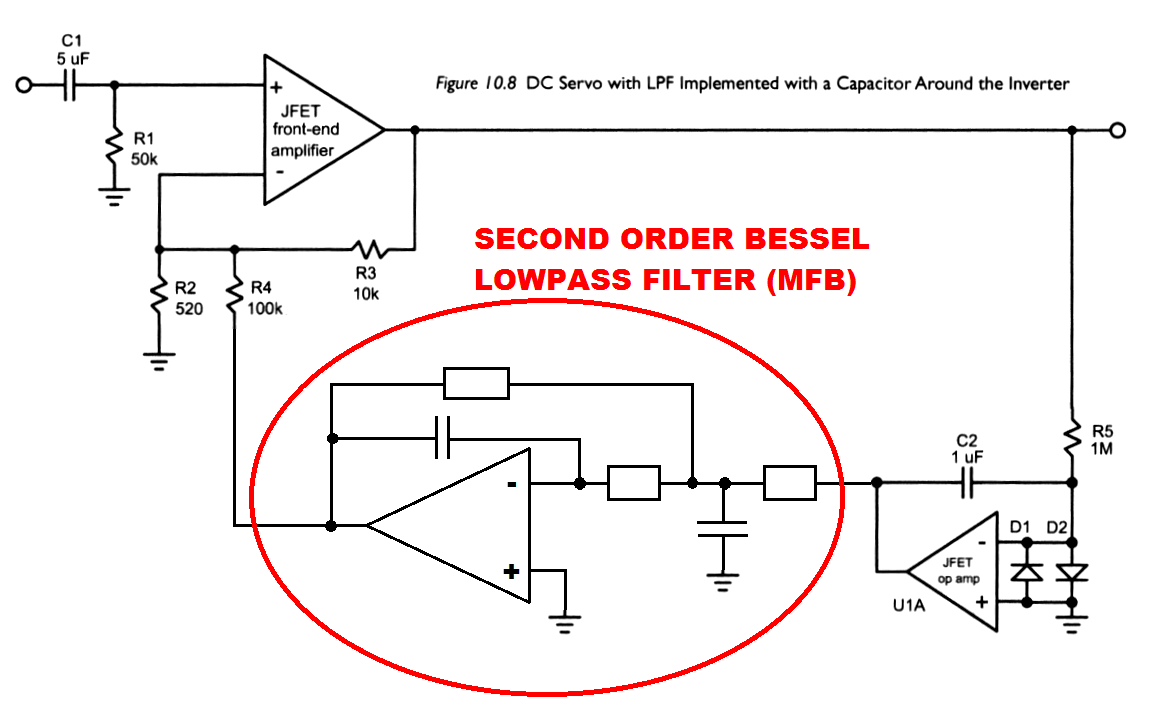Bob did you notice the price on your first addition has dropped considerably.
No longer $1500.00.
Ha, Ha! I wonder if any sold at those crazy prices.
Cheers,
Bob
Methinks "settling time" may refer to the entire control loop, which comprises the audio power amplifier's forward path, the first stage of the DC servo (inverting integrator), and the proposed second stage (inverting N-th order lowpass active filter with alignment X).
Apply a unit impulse and watch it settle (or watch it oscillate)
I sim it. An integrator followed by 2n butterworth low pass filter around 3Hz. An impluse of power supply, the output was settle after few hundred mili second. A sine and pulse input was good, no oscillation. Frequency response is not peaking.
Re: Doublecross
Seems to me that D1 here provides something very similar to the tension bias:
https://www.diyaudio.com/forums/solid-state/125317-easiest-build-class.html#post1546823
The example is low power for headphones but he also mentions using power OP amps for higher power,
not that it matters with regard to the concept.
@jcx what do you think?
Making that inverter-LPF in the second op amp into a 2nd order filter at little expense is a neat idea. My only question is how much difference does it make in the real world after having already put in the first order of extra filtering.
Bob, I am imagining that it might interact with this passage from your 2nd edition:
Perhaps turning the second opamp into an Nth order lowpass filter, has the beneficial side effect of filtering out and discarding any audible distortion introduced by the first opamp (?). Which might mean that you can improve distortion performance; OR, that you can use much cheaper opamps and get the same distortion performance.It is possible for the servo op amp to create distortion that will make its way onto the output of the amplifier. ... The very best way to reduce injected servo noise and distortion is to use high-quality parts and audio design practices in the servo
Bob, I am imagining that it might interact with this passage from your 2nd edition:
Perhaps turning the second opamp into an Nth order lowpass filter, has the beneficial side effect of filtering out and discarding any audible distortion introduced by the first opamp (?). Which might mean that you can improve distortion performance; OR, that you can use much cheaper opamps and get the same distortion performance.

These are good points. I usually use an OPA2134 for the DC servo and a polypropylene integrator capacitor.
Cheers,
Bob
Another small ambiguity. On page 432 reference is made to RE1 in Figure 18.11 but there is no RE1 in Figure 18.11 - only R1 to R3. This could be confusing for a beginner using the book as a learning aid - refer to the resistor in question as R1 explicitly?
Thanks! Pointing out errors or ambiguities that you find is very helpful. I hope to put an errata page up on my website for the benefit of all readers. If there is a second printing (usually years down the road after a few thousand copies are sold), I'll have an opportunity to make those corrections.
Cheers,
Bob
...I hope to put an errata page up on my website for the benefit of all...
Cheers,
Bob
This would be helpful for me. Is there currently a list floating around anywhere, or should I just comb through the thread for now?
This would be helpful for me. Is there currently a list floating around anywhere, or should I just comb through the thread for now?
I hope to put up an errata page on my web site in a week or two with all errata found so far, and I'll try to keep it updated as new errata are found.
Cheers,
Bob
I enjoyed the commentary on passive components, good advice on NP electrolytics.
But what I enjoyed even more was the discussion of using SMPTE methodology for thermal "memory distortion" (do I have that correct?), and the Chapter 17 discussion of ThermalTrak.
Thanks, Jack. Yes, you are correct about the methodology for exploring thermal memory distortion.
Cheers,
Bob
What a colossal effort, Mr. Cordell!
I read bits and pieces every morning - so much to learn.
Cheers
Thank you for your very kind words!
If you are so inclined, you might want to do an Amazon review
Cheers,
Bob
Thank you for your very kind words!
If you are so inclined, you might want to do an Amazon review.
Cheers,
Bob
I will, indeed, Bob!
Cheers,
Greg
Jack where did you find that discussion on SMPTE method?
Jan
I knew that would wake you up -- page 380.
- Home
- Amplifiers
- Solid State
- Bob Cordell's Power amplifier book